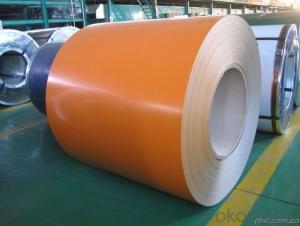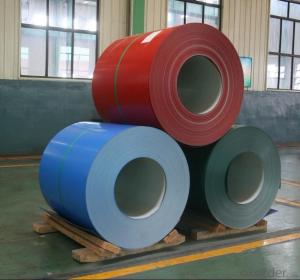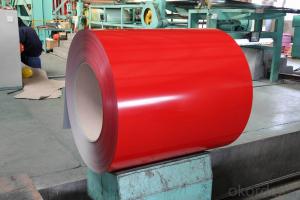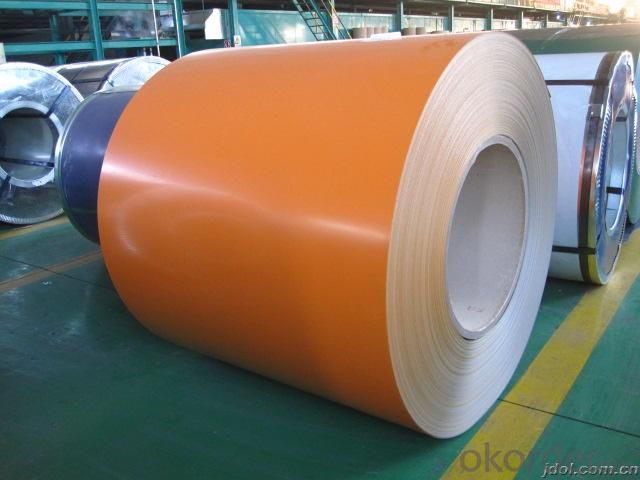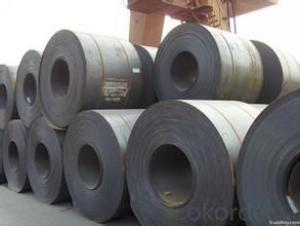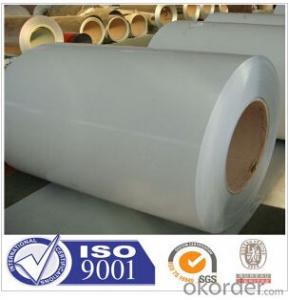Prepainted Galvanized Steel Coil Good Quality-CGC340
- Loading Port:
- China main port
- Payment Terms:
- TT OR LC
- Min Order Qty:
- 50 m.t.
- Supply Capability:
- 15000 m.t./month
OKorder Service Pledge
OKorder Financial Service
You Might Also Like
Prepainted Galvanized Steel Coil Good Quality-CGC340
1. Structure of Prepainted Galvanized steel Coil :
•Prepainted galvanized steel qualified with excellent decorative ,formability ,corrosion resistance ,coating adhesion ,can keep for a long time as well as maintain fresh color .For color coated steel sheet can obtain good economic benefit by steel belt wood ,efficient in construction and save energy ,prevent pollution etc. Which is an ideal material for manufacturing board.
2.Main Features of Prepainted Galvanized steel Coil:
• Excellent process capability
• Smooth and flat surface
• Workability, durability
• Excellent heat resistance performance
• High strength
• Good formability
• Good visual effect
3.Prepainted Galvanized steel Coil Images
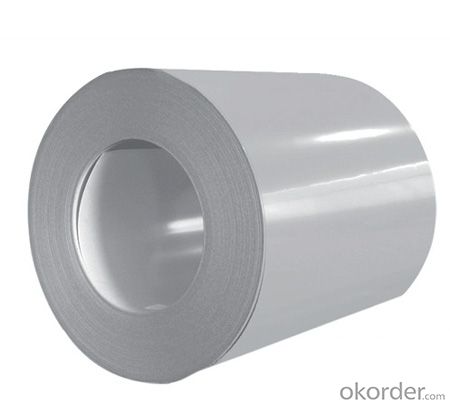
4.Prepainted Galvanized steel Coil Specification
Standard: ASTM, GB,JIS,JIS G3302 ASTM 755 EN10169
Grade: DX51D CGCC CS
Thickness: 0.18mm~1.2mm,
Width: 600-1250mm
Coil weight:3-12 MT
Coil ID:508/610mm
Chemical composition:
C | Si | Mn | Cr | Ni | P | S |
0.150 | 0.476 | 11.231 | 12.50 | 0.900 | 0.039 | 0.010
|
5.FAQ of Prepainted Galvanized steel Coi
We have organized several common questions for our clients,may help you sincerely:
1.How do you control your quality
We have established the international advanced quality management system,every link from raw material to final product we have strict quality test;We resolutely put an end to unqualified products flowing into the market. At the same time, we will provide necessary follow-up service assurance.
2.How long we will receive the goods ?
After receiving your deposit or workable lc ,our normal shipment date is 15-20days,and it takes around 28 days to reach your port of destination. But is up to different destination
3. What is your moq
Normally our moq is 25per size ,but it is up to different size
- Q: How are steel coils used in the production of aerospace parts?
- Due to their strength, durability, and versatility, steel coils find extensive use in the aerospace industry for the production of aerospace parts. Made from high-quality carbon steel, these coils are formed into a coil shape, facilitating their transportation and storage. In the aerospace sector, steel coils play a crucial role in manufacturing different components, including structural parts, engine parts, landing gear, and fasteners. Specifically, steel coils are extensively employed in the fabrication of aircraft frames and fuselage structures. These coils are often cut, shaped, and welded to create the necessary structural components, which contribute to the aircraft's strength and stability. Another significant application of steel coils in aerospace production is the manufacturing of engine parts. Complex shapes are formed from the processed steel coils to produce components like turbine blades, shafts, and casings. These components must withstand high temperatures, pressure, and stress, and steel coils possess the requisite strength and heat resistance for such demanding applications. Furthermore, steel coils find utility in the production of landing gear, which supports the aircraft during takeoff, landing, and ground operations. The processed steel coils are shaped into various parts of the landing gear system, including struts, beams, and brackets. These components undergo rigorous testing and require excellent strength, toughness, and fatigue resistance, all of which are provided by steel coils. Additionally, steel coils are commonly employed in the manufacturing of fasteners essential for aerospace applications. Bolts, screws, and rivets play a crucial role in joining different components together, ensuring structural integrity and safety. Steel coils are processed and formed into the desired shapes for these fasteners, offering the necessary strength and reliability for these critical connections. In summary, steel coils are indispensable in the production of aerospace parts due to their exceptional mechanical properties and reliability. Their versatility enables various shaping and processing techniques, allowing for the creation of complex and high-performance components. By incorporating steel coils into aerospace manufacturing, the industry can ensure the production of durable, safe, and efficient aircraft.
- Q: What are the challenges in coil slitting for narrow strip widths?
- Coil slitting for narrow strip widths presents a number of challenges. One key challenge is the need to maintain precision and accuracy throughout the slitting process. Even the smallest misalignment or deviation can result in significant defects or inconsistencies in the final product. Therefore, it is important to calibrate and adjust the slitting equipment carefully to ensure accurate cuts. Another challenge is the risk of material damage or deformation during slitting. Narrow strip widths are more susceptible to distortion, wrinkling, or edge cracking, especially if the material is not handled or supported properly. To minimize potential damage, it is necessary to feed the material smoothly through the slitting machine and control the tension effectively. In addition, handling and transporting slit coils can be challenging due to their narrow width. These coils are prone to bending, twisting, or telescoping, which can cause difficulties in stacking, storage, or transportation. To maintain the shape and integrity of the coils, proper packaging and handling techniques must be employed throughout the supply chain. Furthermore, narrow strip widths often require more frequent blade changes during slitting. This adds complexity and time to the setup and maintenance process, as the blades need to be carefully selected and replaced for optimal cutting results. Skilled technicians are crucial for efficiently and effectively handling these blade changes. Overall, while coil slitting for narrow strip widths offers cost savings and increased material utilization, it also comes with challenges that need to be addressed. These challenges include maintaining accuracy, preventing material damage, ensuring proper handling and transportation, and managing blade changes effectively. By understanding and addressing these challenges, manufacturers can optimize their coil slitting operations and produce high-quality narrow strip products.
- Q: What are the different finishes available for steel coils?
- There are several different finishes available for steel coils, each offering its own unique set of characteristics and benefits. Some of the most common finishes include: 1. Hot-dip galvanized: This finish involves immersing the steel coil in a bath of molten zinc, which creates a protective layer that prevents corrosion and rust. It provides excellent durability and long-term protection against harsh environmental conditions. 2. Electro-galvanized: Similar to hot-dip galvanizing, this finish uses an electrical current to apply a thin layer of zinc onto the steel coil. It offers good corrosion resistance and aesthetics, making it suitable for various applications. 3. Galvannealed: This finish combines the benefits of galvanizing and annealing processes. The steel coil is first galvanized and then annealed, resulting in a matte grey appearance with enhanced paint adhesion. Galvannealed finishes are commonly used in automotive and appliance industries. 4. Pre-painted: Also known as coil coating, this finish involves applying a layer of paint onto the steel coil before it is formed into its final product. Pre-painted finishes offer a wide range of colors, textures, and gloss levels, allowing for customization and improved aesthetics. 5. Stainless steel: Steel coils can also be finished with a layer of stainless steel, which provides excellent resistance to corrosion, heat, and chemicals. Stainless steel finishes are often utilized in applications where hygiene, durability, and a high-quality appearance are essential, such as in the food and beverage industry. 6. Cold-rolled: This finish involves passing the steel coil through a series of rollers at room temperature, resulting in a smooth, polished surface. Cold-rolled finishes offer improved dimensional accuracy, surface quality, and flatness, making them suitable for applications that require tight tolerances and a refined appearance. 7. Metallic coated: This finish involves applying a layer of a metallic coating, such as aluminum or zinc-aluminum alloy, onto the steel coil. Metallic coated finishes offer excellent corrosion resistance, lightweight properties, and aesthetic versatility. Overall, the choice of finish for steel coils depends on the specific requirements of the application, considering factors such as corrosion resistance, aesthetics, durability, and cost-effectiveness. It is important to consult with industry experts and manufacturers to determine the most suitable finish for a particular project.
- Q: Ok, I have motorcycle classes and im afraid that I wont feel the gear shifter when shifting. So I want to make the boot softer from the toes where the steel is at so i can feel the gear shift with my toes. When i walk and bump into something by accident with my boots I dont feel anything I almost dont notice it. So I think i will be a problem since I wont be able to feel anything.
- You're not from this world, are you?
- Q: What are the different types of steel coil slitting methods?
- There are three main types of steel coil slitting methods: rotary slitting, loop slitting, and oscillating slitting. Rotary slitting involves using a circular knife to cut the coil into smaller strips. Loop slitting involves creating a loop in the coil and then cutting it using a straight knife. Oscillating slitting involves using a reciprocating knife to make a back-and-forth motion while cutting the coil. These methods allow for precise and efficient slitting of steel coils into narrower strips.
- Q: What are the main factors to consider when selecting a steel coil supplier?
- When selecting a steel coil supplier, some of the main factors to consider include the supplier's reputation and experience in the industry, the quality and consistency of their products, their ability to meet your specific requirements and timelines, their customer service and support, as well as their pricing and overall value proposition.
- Q: how many persent of manganese in all types of carbon steel
- Not more than 1.65 % of manganese in carbon steel. *Carbon steel, also called plain carbon steel, is steel where the main alloying constituent is carbon. The American Iron and Steel Institute (AISI) defines carbon steel as: Steel is considered to be carbon steel when no minimum content is specified or required for chromium, cobalt, columbium, molybdenum, nickel, titanium, tungsten, vanadium or zirconium, or any other element to be added to obtain a desired alloying effect; when the specified minimum for copper does not exceed 0.40 percent; or when the maximum content specified for any of the following elements does not exceed the percentages noted: manganese 1.65, silicon 0.60, copper 0.60 *AISI 1040 is a carbon steel which is having a 0.60-0.90 % of manganese.
- Q: What are the different types of steel coil storage methods?
- There are several different types of steel coil storage methods, including vertical stacking, horizontal stacking, coil cradles, and coil racks.
- Q: How are steel coils used in the manufacturing of safety systems?
- Steel coils are used in the manufacturing of safety systems as they serve as a key component for reinforcement and support. These coils are often used in the construction of structural elements such as beams, columns, and frames, providing strength and stability to ensure the safety and durability of the overall system. Additionally, steel coils are utilized in the production of safety equipment such as guardrails, barricades, and safety barriers, offering protection and preventing accidents in various industries and applications.
- Q: I just bought a dpms ar15 and it says if I shoot steel cases (laquer coated) or foreign ammo it voids the warranty. But before I knew this I bought 200 rounds of Russian steel cased anmo. Think I should just shoot there two hundred and not buy anymore? Some people say all they shoot is steel cased ammo and have no problemAny advice is appreciated
- I would probably buy a box of 20 brass cased ones and shoot them first to see that the gun works if you really believe that steel cased/foreign ammo voids the warranty. That way you will know that the rifle is functional from the factory. My son has a Rem 700 SPS Varmint that has only fired handloads and there are a couple of other rifles that have never had a factory round in them and the manufacturers claim that hand loads void warranties too.
Send your message to us
Prepainted Galvanized Steel Coil Good Quality-CGC340
- Loading Port:
- China main port
- Payment Terms:
- TT OR LC
- Min Order Qty:
- 50 m.t.
- Supply Capability:
- 15000 m.t./month
OKorder Service Pledge
OKorder Financial Service
Similar products
Hot products
Hot Searches
Related keywords
